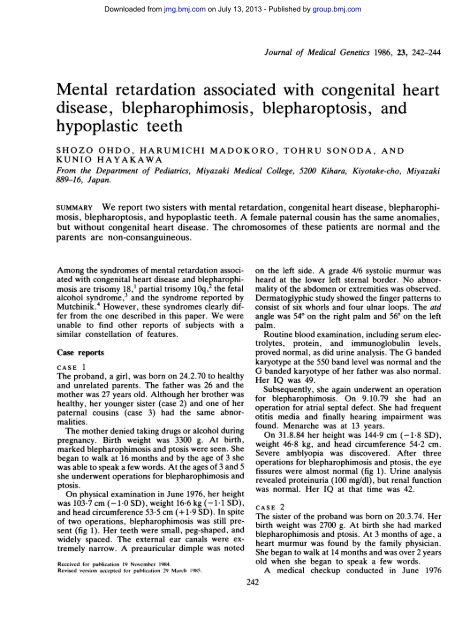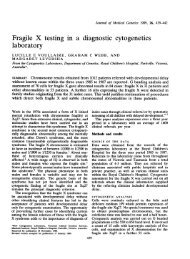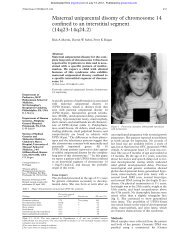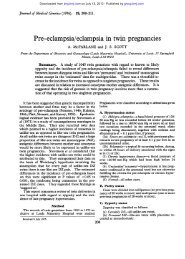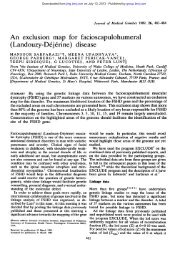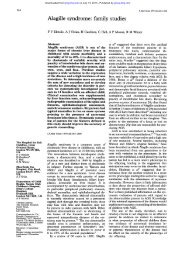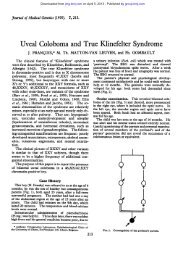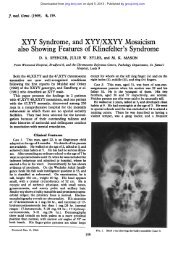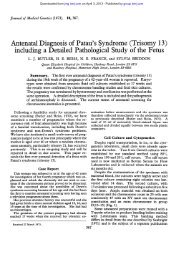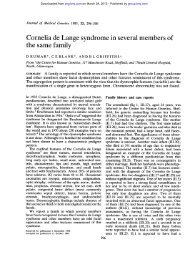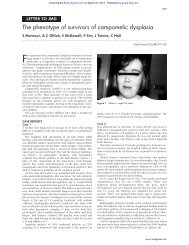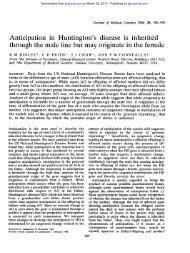disease, blepharophimosis, blepharoptosis, and hypoplastic teeth
disease, blepharophimosis, blepharoptosis, and hypoplastic teeth
disease, blepharophimosis, blepharoptosis, and hypoplastic teeth
You also want an ePaper? Increase the reach of your titles
YUMPU automatically turns print PDFs into web optimized ePapers that Google loves.
Journal of Medical Genetics 1986, 23, 242-244<br />
Mental retardation associated with congenital heart<br />
<strong>disease</strong>, <strong>blepharophimosis</strong>, <strong>blepharoptosis</strong>, <strong>and</strong><br />
<strong>hypoplastic</strong> <strong>teeth</strong><br />
SHOZO OHDO, HARUMICHI MADOKORO, TOHRU SONODA, AND<br />
KUNIO HAYAKAWA<br />
From the Department of Pediatrics, Miyazaki Medical College, 5200 Kihara, Kiyotake-cho, Miyazaki<br />
889-16, Japan.<br />
SUMMARY We report two sisters with mental retardation, congenital heart <strong>disease</strong>, <strong>blepharophimosis</strong>,<br />
<strong>blepharoptosis</strong>, <strong>and</strong> <strong>hypoplastic</strong> <strong>teeth</strong>. A female paternal cousin has the same anomalies,<br />
but without congenital heart <strong>disease</strong>. The chromosomes of these patients are normal <strong>and</strong> the<br />
parents are non-consanguineous.<br />
Among the syndromes of mental retardation associated<br />
with congenital heart <strong>disease</strong> <strong>and</strong> <strong>blepharophimosis</strong><br />
are trisomy 18,' partial trisomy 10q, the fetal<br />
alcohol syndrome,3 <strong>and</strong> the syndrome reported by<br />
Mutchinik.4 However, these syndromes clearly differ<br />
from the one described in this paper. We were<br />
unable to find other reports of subjects with a<br />
similar constellation of features.<br />
Case reports<br />
Downloaded from<br />
jmg.bmj.com on July 13, 2013 - Published by group.bmj.com<br />
CASE 1<br />
The prob<strong>and</strong>, a girl, was born on 24.2.70 to healthy<br />
<strong>and</strong> unrelated parents. The father was 26 <strong>and</strong> the<br />
mother was 27 years old. Although her brother was<br />
healthy, her younger sister (case 2) <strong>and</strong> one of her<br />
paternal cousins (case 3) had the same abnormalities.<br />
The mother denied taking drugs or alcohol during<br />
pregnancy. Birth weight was 3300 g. At birth,<br />
marked <strong>blepharophimosis</strong> <strong>and</strong> ptosis were seen. She<br />
began to walk at 16 months <strong>and</strong> by the age of 3 she<br />
was able to speak a few words. At the ages of 3 <strong>and</strong> 5<br />
she underwent operations for <strong>blepharophimosis</strong> <strong>and</strong><br />
ptosis.<br />
On physical examination in June 1976, her height<br />
was 103-7 cm (-1-0 SD), weight 16-6 kg (-1-1 SD),<br />
<strong>and</strong> head circumference 53-5 cm (+1-9 SD). In spite<br />
of two operations, <strong>blepharophimosis</strong> was still present<br />
(fig 1). Her <strong>teeth</strong> were small, peg-shaped, <strong>and</strong><br />
widely spaced. The external ear canals were extremely<br />
narrow. A preauricular dimple was noted<br />
Rcccived for publication 19 Novcmhcr 1984.<br />
Reviscd version accepted for publicattion 29 Mairch 1985.<br />
on the left side. A grade 4/6 systolic murmur was<br />
heard at the lower left sternal border. No abnormality<br />
of the abdomen or extremities was observed.<br />
Dermatoglyphic study showed the finger patterns to<br />
consist of six whorls <strong>and</strong> four ulnar loops. The atd<br />
angle was 540 on the right palm <strong>and</strong> 56° on the left<br />
palm.<br />
Routine blood examination, including serum electrolytes,<br />
protein, <strong>and</strong> immunoglobulin levels,<br />
proved normal, as did urine analysis. The G b<strong>and</strong>ed<br />
karyotype at the 550 b<strong>and</strong> level was normal <strong>and</strong> the<br />
G b<strong>and</strong>ed karyotype of her father was also normal.<br />
Her IQ was 49.<br />
Subsequently, she again underwent an operation<br />
for <strong>blepharophimosis</strong>. On 9.10.79 she had an<br />
operation for atrial septal defect. She had frequent<br />
otitis media <strong>and</strong> finally hearing impairment was<br />
found. Menarche was at 13 years.<br />
On 31.8.84 her height was 144-9 cm (-1-8 SD),<br />
weight 46-8 kg, <strong>and</strong> head circumference 54-2 cm.<br />
Severe amblyopia was discovered. After three<br />
operations for <strong>blepharophimosis</strong> <strong>and</strong> ptosis, the eye<br />
fissures were almost normal (fig 1). Urine analysis<br />
revealed proteinuria (100 mg/dl), but renal function<br />
was normal. Her IQ at that time was 42.<br />
CASE 2<br />
The sister of the prob<strong>and</strong> was born on 20.3.74. Her<br />
birth weight was 2700 g. At birth she had marked<br />
<strong>blepharophimosis</strong> <strong>and</strong> ptosis. At 3 months of age, a<br />
heart murmur was found by the family physician.<br />
She began to walk at 14 months <strong>and</strong> was over 2 years<br />
old when she began to speak a few words.<br />
A medical checkup conducted in June 1976<br />
242
Downloaded from<br />
jmg.bmj.com on July 13, 2013 - Published by group.bmj.com<br />
Mental retardation, congenital heart <strong>disease</strong>, <strong>blepharophimosis</strong>, <strong>blepharoptosis</strong>, <strong>and</strong> <strong>hypoplastic</strong> <strong>teeth</strong><br />
showed her height to be 82 5 cm (-1-3 SD), weight<br />
11-8 kg, <strong>and</strong> head circumference 48-0 cm. Blepharophimosis<br />
<strong>and</strong> ptosis were present (fig 2). Her<br />
external auditory canals were not narrow. A grade<br />
3/6 holosystolic murmur was heard at the lower left<br />
sternal border. The heart murmur was diagnosed as<br />
being due to a ventricular septal defect. Dermatoglyphic<br />
study showed the fingertip patterns to consist<br />
of four whorls, four ulnar loops, one radial loop,<br />
<strong>and</strong> one arch. The atd angle was 790 on the right<br />
palm <strong>and</strong> 720 on the left. The G b<strong>and</strong>ed karyotype,<br />
ECG, <strong>and</strong> chest x-ray were normal. The develop-<br />
FIG 1 The prob<strong>and</strong> at 5 <strong>and</strong> 14 years of age.<br />
FIG 2 The prob<strong>and</strong>'s sister at 2 <strong>and</strong> 10 years of age.<br />
mental quotient was about 60. She frequently had<br />
otitis media. The heart murmur disappeared by the<br />
age of 5.<br />
On 31.8.84 her height was 126-4 cm (-1.5 SD),<br />
weight 30 9 kg, <strong>and</strong> head circumference 52-5 cm. In<br />
spite of three operations for <strong>blepharophimosis</strong> <strong>and</strong><br />
ptosis, these conditions were not fully corrected (fig<br />
2). Mild microphthalmia <strong>and</strong> severe amblyopia were<br />
discovered. Her <strong>teeth</strong> were small <strong>and</strong> widely spaced.<br />
Hearing impairment was also noted. Her IQ was 37.<br />
Although urine analysis detected proteinuria, her<br />
renal function was normal.<br />
I<br />
s ..<br />
.<br />
.,U.l<br />
1'.<br />
.0 .7- F.,;i2 :,<br />
.; "i<br />
%i<br />
_SFpo<br />
243
244<br />
Downloaded from<br />
jmg.bmj.com on July 13, 2013 - Published by group.bmj.com<br />
FIG 3 The prob<strong>and</strong>'s cousin at 9 <strong>and</strong> 1 7yvears<br />
of age.<br />
CASE 3<br />
The patient was born on 20.1.68 to healthy <strong>and</strong><br />
unrelated parents. The father was 31 <strong>and</strong> the mother<br />
29 years of age. The mother is an older sister of the<br />
father of the prob<strong>and</strong>. The older brother of the<br />
patient is healthy. The mother denies having taken<br />
any drug or suffered any illness during pregnancy.<br />
The patient was born with asphyxia, birth weight<br />
2300 g. She began to walk after the age of 2 <strong>and</strong><br />
began to say a few words at about the same time.<br />
She had <strong>blepharophimosis</strong> <strong>and</strong> ptosis to the same<br />
degree as her cousins <strong>and</strong> was operated on for those<br />
conditions when she was 3 <strong>and</strong> 5. She had marked<br />
amblyopia. At the age of 6, she was admitted to an<br />
institute for the mentally retarded.<br />
A medical checkup in the institute in 1976 showed<br />
that her physical growth was almost normal.<br />
Although the <strong>blepharophimosis</strong> <strong>and</strong> ptosis had been<br />
improved by the two operations, these conditions<br />
could still be seen (fig 3). Her <strong>teeth</strong> were small,<br />
conical, <strong>and</strong> widely spaced. There was no heart<br />
murmur. No abnormality of the abdomen or<br />
extremities was noted. Dermatoglyphic study showed<br />
the fingertip patterns to consist of five ulnar loops,<br />
four radial loops, <strong>and</strong> one arch. The atd angle was<br />
550 on the right palm <strong>and</strong> 530 on the left. Routine<br />
blood tests proved normal. Her IQ was 50.<br />
In September 1984, her physical development was<br />
within normal limits. Blepharophimosis <strong>and</strong> ptosis<br />
were still noted (fig 3) as were amblyopia <strong>and</strong><br />
hearing impairment. Her IQ was 39. Urine analysis<br />
detected traces of proteinuria.<br />
Discussion<br />
The patients described in this paper showed the<br />
following characteristic combination of congenital<br />
anomalies: mental retardation (3/3), <strong>blepharophimosis</strong><br />
with ptosis (3/3), <strong>hypoplastic</strong> <strong>teeth</strong> (3/3),<br />
S Ohdo, H Madokoro, T Sonoda, <strong>and</strong> K Hayakawa<br />
..erof<br />
.... .K f, ..m<br />
amblyopia (3/3), <strong>and</strong> congenital heart <strong>disease</strong> (2/3).<br />
In case 3, the possibility of spontaneous closure of a<br />
ventricular septal defect before our first examination<br />
could not be ruled out.<br />
Many malformation syndromes associated with<br />
mental retardation or congenital heart <strong>disease</strong> are<br />
known.5 However, as far as we are able to determine,<br />
there have been no reports of the combination<br />
of malformations described in this paper. The<br />
malformations found in two sisters reported by<br />
Mutchinik4 in 1972 somewhat resemble those found<br />
in our patients. However, the white skin, microcephaly,<br />
prognathism, <strong>and</strong> pigeon breast noted in<br />
Mutchinik's cases were not present in our cases.<br />
Also, the <strong>hypoplastic</strong> <strong>teeth</strong> observed in our patients<br />
were not described in Mutchinik's report.4<br />
It is impossible to determine the aetiology of the<br />
rnalformation syndrome described in this paper.<br />
However, the fact that three patients were found in<br />
the same kindred suggests that the syndrome is<br />
hereditary. The mode of inheritance is compatible<br />
with autosomal recessive inheritance, autosomal<br />
dominant inheritance with low penetrance, <strong>and</strong><br />
multifactorial inheritance.<br />
References<br />
lSmith DW. Recognizable patterns of human malformation. 3rd<br />
ed. Philadelphia: Saunders, 1982:14-7.<br />
2 Schinzel A. Catalogue of unbalanced chromosome aberrations in<br />
man. Berlin: Walter de Gruyter, 1984:401-9.<br />
3Clarren SK, Smith DW. The fetal alcoholic syndrome. N Engl J<br />
Med 1978;298:1063-7.<br />
4Mutchinik 0. A syndrome of mental <strong>and</strong> physical retardation,<br />
speech disorders <strong>and</strong> peculiar facies in two sisters. J Med Genet<br />
1972;9:60-3.<br />
Bergsma D. Birth defects compendium. 2nd ed. New York:<br />
Alan R Liss, 1979.<br />
Correspondence <strong>and</strong> requests for reprints to Dr S<br />
Ohdo, Department of Pediatrics, Miyazaki Medical<br />
College, 5200 Kihara, Kiyotake-cho, Miyazaki 889-<br />
16, Japan.
Downloaded from<br />
jmg.bmj.com on July 13, 2013 - Published by group.bmj.com<br />
References<br />
Email alerting<br />
service<br />
Notes<br />
Mental retardation associated<br />
with congenital heart <strong>disease</strong>,<br />
<strong>blepharophimosis</strong>,<br />
<strong>blepharoptosis</strong>, <strong>and</strong> <strong>hypoplastic</strong><br />
<strong>teeth</strong>.<br />
S Ohdo, H Madokoro, T Sonoda, et al.<br />
J Med Genet 1986 23: 242-244<br />
doi: 10.1136/jmg.23.3.242<br />
Updated information <strong>and</strong> services can be found at:<br />
http://jmg.bmj.com/content/23/3/242<br />
These include:<br />
Article cited in:<br />
http://jmg.bmj.com/content/23/3/242#related-urls<br />
To request permissions go to:<br />
http://group.bmj.com/group/rights-licensing/permissions<br />
To order reprints go to:<br />
http://journals.bmj.com/cgi/reprintform<br />
To subscribe to BMJ go to:<br />
http://group.bmj.com/subscribe/<br />
Receive free email alerts when new articles cite this<br />
article. Sign up in the box at the top right corner of<br />
the online article.


